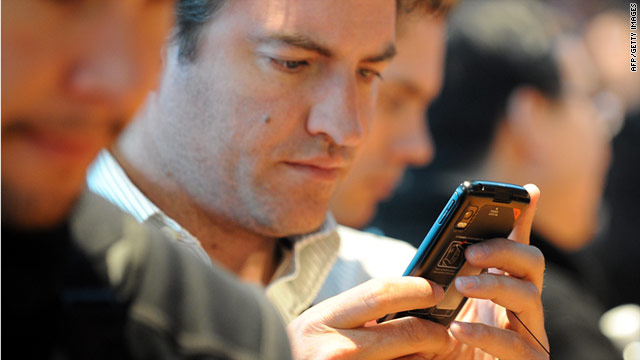Android invasion arrives at CES
Las Vegas, Nevada (CNN) -- Google doesn't have a booth at the Consumer Electronics Show, but the company's Android software is practically everywhere.
As expected, smartphones maintain a major presence at CES. Despite Microsoft and Research in Motion showcasing their wares, the announcements and excitement is all around Google's Android.
Every new 4G smartphone and tablet announced by the four major cellular carriers at or during CES runs on Android.
Verizon Wireless showcased four smartphones at a news event on Thursday -- LG's Revolution, HTC's Thunderbolt, Motorola's Droid Bionic and a yet-to-be-named offering from Samsung. Touch-screen tablets were also on display with Samsung's Galaxy Tab and Motorola's Xoom.
All six mobile devices, which are slated for release in the first half of the year starting as early as March, run on Android.
"At the same time that we were building out the [4G]area LTE network, the Android operating system really became a reality," Verizon Wireless CEO Dan Mead said in an interview on Thursday.
AT&T announced three smartphones on Wednesday, which take advantage of the carriers' latest network protocol. All three, from Motorola's Atrix 4G, HTC's Inspire 4G and Samsung's Infuse 4G, were Androids.
T-Mobile unveiled two new tablets -- LG G-Slate and Dell Streak 7 -- but no new smartphones at its event. Both tablets were running Android.
During the week of CES, Sprint Nextel announced one new phone, the Evo Shift 4G from HTC, which runs on -- take a guess.
At Research in Motion's booth, the company showcases mainly the PlayBook, alongside BlackBerry phones that are already on the market.
When questioned on phones, RIM co-CEO Mike Lazaridis reiterated that the company is hard at work on the next iteration of BlackBerry. It's based on the operating system that runs the PlayBook, and these "super phones," as he reportedly called them, will have fast dual-core processors inside.
But Motorola Mobility leapt past RIM with an Android phone that packs a dual-core chip. Thanks to the added processing power, the Atrix 4G can dock to a monitor or laptop shell to become a desktop computer running a modified version of Android.
For Microsoft CEO Steve Ballmer's CES keynote, he focused the Windows Phone 7 presentation on applications -- now totally more than 5,500 -- instead of new hardware. Perhaps that's because carrier partners had nothing new to show.
Ballmer concluded the phone portion of his keynote by announcing a new feature coming soon: copy-and-paste, something every major competitor already offers. Needless to say, the crowd was not impressed.
On display at its booth, Microsoft had many of the nine Windows Phone 7 devices that are already available in stores. Though the company didn't announce new phones, a Microsoft mobile director told the Seattle Times that Windows Phone 7 products would be available on Verizon and Sprint by June 30.
"We're going to be a multiple operating-system company," Verizon's Mead said. "We have a strong business relationship with Microsoft. We are interested in that."
The variety of phone types that carriers offer is one area of competition.
"Not only do we have every major operating system," said AT&T Marketing Chief David Christopher at his company's Wednesday conference, "but we have the best smartphones for those operating systems."
Despite these statements of breadth, Android was practically the only act in town this week.
Last year, Google had a table at one of the three main nightly events associated with CES. This year, the company just held a small party and rented a private meeting room.
Google is leaving it to the manufacturers to evangelize its platform.
Expecting to make money from ads, Google provides Android for free to gadget makers to install, tinker with and sell on phones. Microsoft charges partners to use Windows Phone 7 and places limits on how they can alter the software.
RIM doesn't license its software. Nor does Nokia, which didn't announce any new products or host a booth, though the company is here in Las Vegas for various small events. Apple, another major smartphone maker and a longtime holdout from CES, also doesn't license software to vendors.
Palm, like the aforementioned three, develops software only for its own hardware. At CES two years ago, the company made a huge splash with the Pre.
This year, however, Palm has a tiny footprint at displays for its new parent company, Hewlett-Packard. No new phones were shown. (HP is holding an event focused on Palm software scheduled for next month.)
With tablets, Android is clearly rising as a top choice for manufacturers, but it's not alone. RIM has its own, and many companies are announcing tablets with Windows 7.
The version of Android made for tablets isn't ready to be demonstrated live, and only two companies say they have products to support it. Others are showcasing Android tablets, but they are based on older Google software that was made for phones, which obviously have smaller screens.
In smartphones, competitors will likely take the stage later this year to shine the spotlight on themselves. But at CES, Android is the star.

This post was written by: Albertolida
Subscribe to:
Post Comments (Atom)




0 Responses to “Android invasion arrives at CES”
Post a Comment